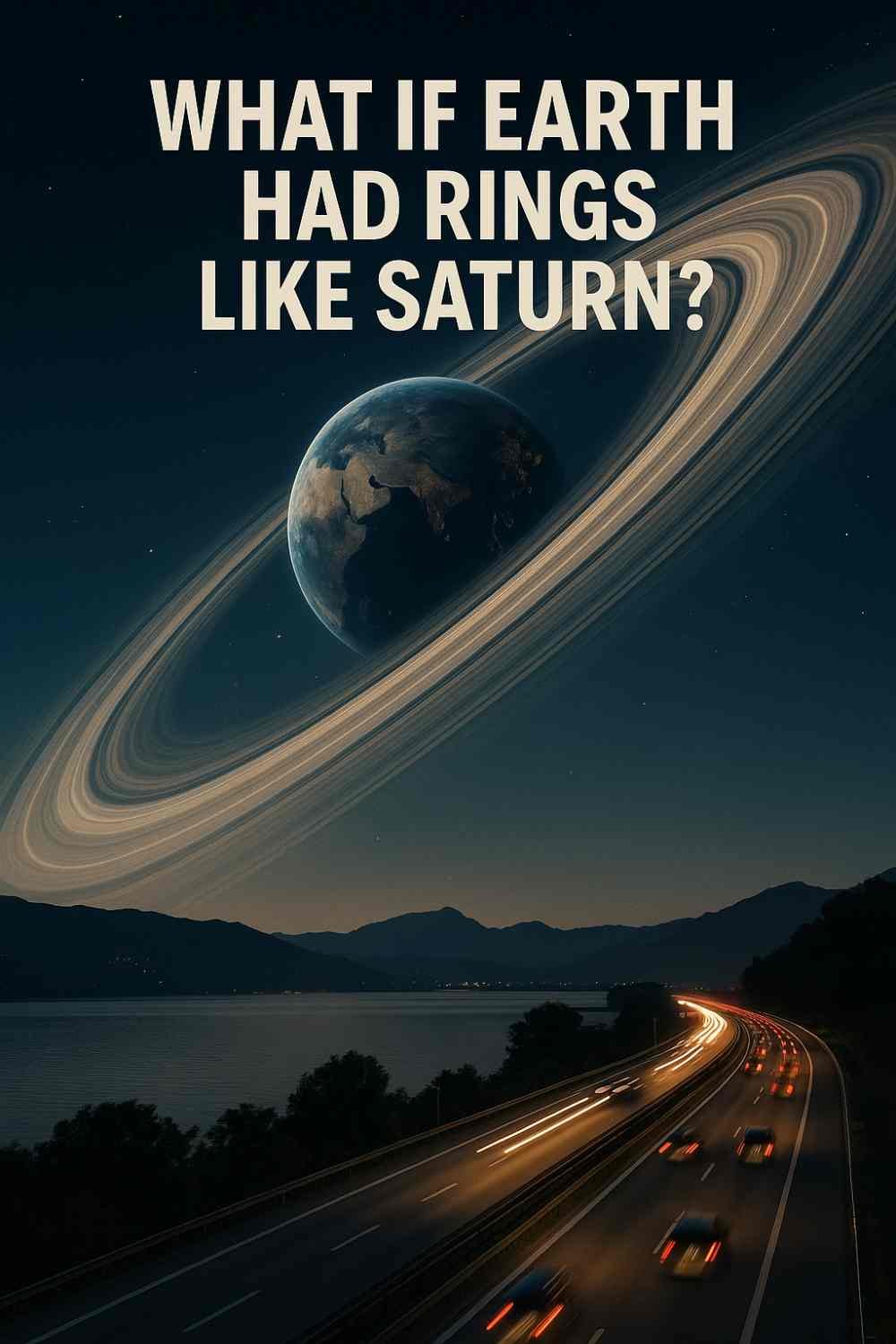What If Earth Had Rings Like Saturn? Night Skies, Tides, and Traffic (A Thought Experiment You’ll Feel in Your Bones)
🌌 A Night Sky You Can’t Ignore
Picture stepping outside at dusk and seeing an ivory highway arcing from horizon to horizon. No telescope. No filters. Just a broad, luminous band hanging over your neighborhood like a celestial bridge. If Earth had Saturn-style rings, they’d dominate the sky the way mountains dominate a landscape. They’d be the first thing kids draw when they sketch “home.”
 Rings wouldn’t look the same from every latitude. Near the equator, the rings would edge across the zenith—thin but intense, like a bright slash. As you walk north or south, the ring plane tilts, widening into a brilliant ribbon that sits lower in the sky. At mid-latitudes, they’d look dramatic: a glowing arch cut with subtle stripes where different ring bands reflect light differently. On certain evenings, you’d see the planet’s shadow carving a crisp, dark notch out of the ring—a daily reminder we live inside an accurate, working model of geometry.
Rings wouldn’t look the same from every latitude. Near the equator, the rings would edge across the zenith—thin but intense, like a bright slash. As you walk north or south, the ring plane tilts, widening into a brilliant ribbon that sits lower in the sky. At mid-latitudes, they’d look dramatic: a glowing arch cut with subtle stripes where different ring bands reflect light differently. On certain evenings, you’d see the planet’s shadow carving a crisp, dark notch out of the ring—a daily reminder we live inside an accurate, working model of geometry.
Even on moonless nights, the rings would add ambient glow. Not daylight—think “permanent ultra-Milky Way.” City planners would write new lighting codes. Astronomers would schedule ring-shadow windows like photographers chase golden hour. Night hikes would have a soft-lit, sci-fi feel—no headlamp, just Earth’s jewelry lighting the trail.
🌙 Moonlight’s Rival, Calendar’s Boss
We’d still have the Moon, but now it’s in competition. The ring brightness would wax and wane with season and angle, reshaping what we think of as “dark” and “bright” nights. Festivals would anchor to ring phases the way many cultures track lunar phases today. There’d be weeks when the ring glow makes midnight feel like permanent twilight, and others when ring shadows dim the sky just enough for the Milky Way to cut through.
Imagine “ring eclipses”—moments when the Sun slides behind the ring plane and the sky turns silvery. Social feeds would go berserk. People would book travel to the latitudes with the cleanest view lines for a given season, the way we chase auroras now.
🌊 Tides on Turbulence: More Than Just Pretty Skies
Rings aren’t just decoration. They’re mass—distributed in a giant disk, tugging on our oceans. The Moon still rules the tides, but the ring system would layer on subtle harmonics, nudging certain coastlines into slightly higher highs and lower lows. In a few regions, the combined pull of Moon + rings + Sun could line up and push “spring tides” into new territory. That means:
Stronger tide differentials in some bays, reshaping salt marshes and sediment flows.
New sweet spots for tidal energy—engineers would map ring-boosted tide patterns and build turbines where water sloshes hardest.
Harbor playbooks rewritten—pilots timing entries and exits not just to the Moon but to seasonal ring geometry.
Would this flood cities? Not by default; the ring’s gravity is tiny compared to the Moon’s. But over decades, even small changes shift coastlines, wetlands, and fisheries. The first atlases after “Ring Day One” would need new legends.
☀️ Weather With a Side of Shadow
Rings throw shade—literally. A slim, high-altitude band of shadow would sweep across latitudes depending on the Sun-Earth-ring alignment. Most days it would be faint and high, but over a year, those shadows could slightly tweak how much sunlight certain bands receive.
It’s not an instant climate overhaul. Think of it like a whisper that, over centuries, changes a choir’s blend. You might see narrow “cooler lanes” that encourage clouds along specific east-west corridors, shifting rainfall by a few percentage points. Farmers would name them. Airlines would route around or through them. Weather apps would add a slider: Ring Shadow Intensity: Low / Medium / Spicy.
Snow belts could sharpen in winter where the ring shadow stacks on short days. Desert margins might get just enough extra cloud seeding to matter. Meanwhile, solar farms in the “ring track” sell power at a slight discount during high-shadow weeks and spike prices when the track migrates off their latitude.
🛰️ Satellites, Space Junk, and the New Traffic Report
A thick ring plane complicates low-Earth orbit the way a six-lane beltway complicates downtown traffic. Even if the densest part of the rings sits higher than most satellites, mission planners would treat the ring plane as a hard boundary: don’t cross unless you must.
Launch windows tighten. Rocket trajectories aim to thread between ring bands or punch through during the thinnest, safest angles.
Satellite constellations split into “north-tilt” and “south-tilt” families, avoiding the ring’s densest lanes. Your GPS might rely on one hemisphere’s network before noon and the other’s after.
Space junk mitigation becomes urgent. Collisions near the ring plane risk sandblasting whole neighborhoods of orbit. Agencies would run daily “ring-plane weather” bulletins for dust density, just like airlines get jet-stream reports.
Air traffic adapts, too. Long-haul pilots would brief for ring glare—that milky, low-angle reflection in the windshield during certain headings. Cabin lights dim, visors down, and approach plates get tiny icons: ☼ = sun glare risk, ⌭ = ring glare risk.
🗺️ Where the Shadow Falls: A New Kind of Geography
Give kids a globe and watch them trace the ring: equatorial countries get the narrow, overhead view; mid-latitudes get the full ribbon. Tourism boards would market this hard:
Equator countries: “Stand under the ring. Look straight up.”
Mid-latitudes: “Widest, brightest arch—perfect for astrophotography.”
High latitudes: “Catch the ring low on the horizon, like a cosmic causeway.”
Maps add a new layer: Annual Ring Visibility Index. Photographers chase crossings of ring shadow with mountain ranges, deserts, and oceans. Picture an alpine lake mirroring a moon-bright arc while the planet’s shadow takes a bite out of it. That’s a poster on a thousand dorm walls.
🌱 Culture, Art, and the Ring That Won’t Leave Your Poems
Myths bloom overnight. Sailor songs about the “chalk road.” Children’s rhymes counting ring bands to fall asleep. Faith traditions mapping holidays to the cleanest ring nights. Designers build amphitheaters aligned to the ring plane so the stage sits under a perfect arc at solstice.
City lights answer back. Architects lace skyline edges with soft uplights that make the ring look like it’s docking with the urban horizon. Photographers get a new genre—ringset—that moment when the band sinks behind a skyline and the whole city inhales.
🧭 Daily Life: From Commutes to Classroom Labs
Commute: Traffic forecasts drop a note—“ring glare on eastbound bridges 6:10–6:45 PM.” Drivers switch routes like they already do for low sun.
Classroom: Physics labs use the ring as a live chalkboard: measure ring parallax at lunch, calculate orbital radii by dinner.
Outdoors: Trail apps show “No-Headlamp Nights” when ring glow and moonlight stack—perfect for safe, mellow night hikes.
Photography: New filter kits labeled RG-1, RG-2 (ring-glare, ring-glow). Your favorite camera YouTuber swears by RG-2.
🔭 Would We See Colors or Just White?
Mostly a soft, pale tone—think dusty ivory. If icy particles dominate, brightness spikes; if rockier dust creeps in, it warms and dims. After meteor showers, the ring could look slightly grainier for a week, like someone smudged chalk across the sky. People would swear they see faint bronze near the inner bands on humid nights. Some of it would be real scattering; some of it would be our pattern-hungry brains doing what they do best.
🛡️ Risks and Safeguards
Rings can’t be a debris minefield for planes or rockets; their densest regions would be well above aircraft altitudes, and aviation stays in air, not vacuum. The real risk is orbital: satellite designers build with thicker shielding. Space agencies agree on ring-plane “right of way” rules. Insurance underwriters give discounts to constellations with orbits that never cross the plane. You’d see a whole industry spring up to model ring density the way we model hurricane cones.
🧠 Why This Thought Experiment Works
Good what-ifs reveal how connected everything is. Add a reflective band in the sky and suddenly you’re rethinking photography, fishery yields, tide maps, solar farm forecasts, airline SOPs, and how kids decorate notebooks. It’s the thrill of systems thinking with a dash of cosmic theater.
Want more brain-stretchers like this? Jump into our daily Bing Homepage Quiz companion for quick hits that sharpen your curiosity, and browse the Weekly Quiz hub to keep your mind in motion.
💡 Quick FAQ (Because You’re Already Wondering)
Would the rings make nights unsafe bright? No. Brighter than our Milky Way, yes; daylight, no.
Would migrating animals get confused? Some might shift timing cues—biologists would study new patterns just like they do with city lights today.
Could we ever “switch them off”? They’re not stadium lights; they’re orbital. But in a pinch, cities can dim themselves to reclaim the stars.
Would there be ring “seasons”? Absolutely. The tilt of Earth would change how we see the ring’s width and brightness over the year. Photographers would plan around it.
🏁 The Takeaway
If Earth wore rings, we’d get a constant reminder that our world is not generic. Nights would glow. Tides would hum a slightly different rhythm. Pilots and astronauts would add a new column to their checklists. Cartographers would need more colors. And poets would never stop trying to name that one shade of silver that lives only in the sky.
Author

A seasoned Finance Head of a leading IT company in the United States, with over a decade of experience in corporate finance, strategic planning, and data-driven decision-making. Passionate about numbers and innovation, Ryan combines financial expertise with a deep understanding of the tech industry to drive sustainable growth and efficiency.

